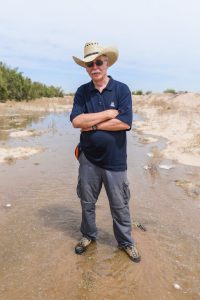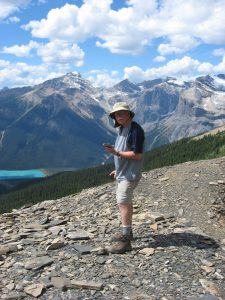Karl Flessa – 1968
I got interested in geology when I took the introductory geology class at Lafayette from Dr. James Dyson, in 1964. I was hooked because of the lectures and the field trips. Now I am currently Professor of Geosciences at the University of Arizona My path from Lafayette to Arizona has taken me many places. While at Lafayette, My paleontology professor, Dr. Richard Faas got me involved in research, providing me with a desk, a research project and a visit to the NE Section meeting of the Geological Society of America. During one of my summers at Lafayette, I got a job as a field assistant for a Lafayette geology alum, Dr. Peter Bretsky, then pursing his Ph.D. at Yale. We travelled along the Appalachians, collecting Upper Ordovician fossils, then preparing them at Yale’s Peabody Museum. I thought: “Hey, you can get paid for having this much fun?”
After graduating from Lafayette in 1968, I went to graduate school at Brown University, where I got my Ph.D. in Geological Sciences in 1973. Sure, my Lafayette coursework was important, but it was the personal guidance, field trips, research opportunities and summer geology jobs I got through Lafayette faculty – and alumni – that were the preparation that mattered most to me. And even though I’ve taught at large public research universities for my entire career, I’ve not forgotten what worked for me at Lafayette and I’ve tried to provide it to my own students ever since.
My first academic job was as an assistant professor at what is now called Stony Book University, on Long Island, New York. When the job offer came from the University of Arizona in Tucson – where there are still more rocks than people, I went for it and moved there in 1977. I’m still here and still teaching and doing research. I served as a department head for Ecology and Evolutionary Biology and later, for the Department of Geosciences. I’m now back to regular teaching and research.
Not that I’ve been in Tucson for all 41 years. One of the great perks of academic jobs are sabbaticals and academic leaves: Semesters or whole years where you can explore new ideas and meet new people. I’ve had the good fortune to have had sabbaticals in Ithaca, N.Y., Germany, Mexico, Australia and, closer to home, with an environmental group. And, I spent two years with the National Science Foundation, in Washington, D.C.

Dr. Flessa Standing in the Middle of the Colorado River in Mexico.
I’m also the chief scientist for the U.S.-Mexico effort to monitor the ecological restoration of the Colorado River Delta. Until 2014, all the Colorado River’s water was diverted for U.S. and Mexican cities and farms before the river could reach its delta and the sea. Thanks to new treaty agreements, a trickle of water is bringing some life back to the delta.
Working with students for so long, I have seen what makes successful geologists. Take advantage of research, summer internships or job opportunities in the earth sciences. The exact topic doesn’t really matter. Publish and/or present results. Go to professional meetings to find out what geologists are doing and what the hot research topics are. More than grades or GREs, it’s the research experiences (and connections and the resulting letters of recommendation) that will get you into a good graduate program.
Take advantage of the opportunities Lafayette offers. Sharpen your programming skills. Sharpen your writing skills. Go beyond “core geology”: learn some geochemistry, geophysics, geobiology/paleobiology, environmental science/environmental policy.

Dr. Flessa at the Burgess Shale in BC, Canada.
When looking for opportunities in geology, Links are ever-changing and quickly out-of-date. Ask your advisors – and you can always ask “Dr. Google”.